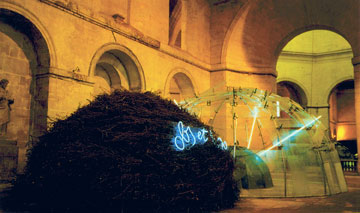Mario Merz/Dan Flavin
dal 8/2/2006 al 27/3/2006
Segnalato da
8/2/2006
Mario Merz/Dan Flavin
Gagosian Gallery, London
Mario Merz. The work, titled "8-5-3," features 3 igloos constructed from metal and glass, covered with fragments of clamps and twigs, and linked by neon tubes. The phrase "Objet cache-toi" or ‘a hiding place' stretches across the structure in blue neon lights. Dan Flavin. Each artwork consists of a single line of fluorescent light suspended across a corner of the gallery space. Muted yet vibrant tones radiate along the gallery walls producing patterns of blues, yellows, greens and pink.

Mario Merz
8-5-3
Feb 9 - Mar 18, 2006
Gagosian Gallery is pleased to announce a large-scale installation by the Italian artist Mario Merz (1925 - 2003). The work, titled "8-5-3," was first shown at Kunsthaus Zurich in 1985 and it features three igloos constructed from metal and glass, covered with fragments of clamps and twigs, and linked by neon tubes. The phrase "Objet cache-toi" or ‘a hiding place' stretches across the structure in blue neon lights.
In 1968 Merz produced "Giap's Igloo," the first of these archetypal dwellings that have become his signature works. Through the igloo motif Merz explores the fundamentals of human existence: shelter, nourishment and humanity's relationship to nature. He examines the lost purity of pre-industrial societies as well as the changing, nomadic identity of modern man. Merz's igloos are comprised of diverse materials including the organic and the artificial, the opaque and the transparent, the heavy and the lightweight.
The title of the exhibition, "8-5-3," corresponds to the diameter of each of the three igloos. Furthermore, it refers to the Fibonacci sequence, a mathematical series of numbers recognized in the 13th century. In this sequence, each numeral is equal to the sum of the two that precede it: 0, 1, 1, 2, 3, 5, 8, and so on. In performances and installations throughout his career Merz employed the Fibonacci sequence to represent the universal principles of creation and growth.
Mario Merz was a leading member of the Italian artistic movement Arte Povera, a term introduced in 1967 by the art critic and curator Germano Celant. The movement was marked by an anti-elitist aesthetic that promoted everyday materials in protest of the dehumanising nature of industrialisation and consumer capitalism. Other artists involved in Arte Povera include Giovanni Anselmo, Alighiero Boetti, Luciano Fabro, Jannis Kounellis, and Giuseppe Penone.
Mario Merz has exhibited at numerous museums worldwide, including at the Solomon R. Guggenheim Museum in New York where a retrospective of his work opened in 1989 and later travelled to Los Angeles Museum of Contemporary Art.
Opening reception: Thursday, February 9th, 6 - 8pm
----------------------------------------------------------
Dan Flavin
Three fluorescent light sculptures
Feb 9 - Mar 28, 2006
Gagosian Gallery is pleased to announce an exhibition of three fluorescent light sculptures by Dan Flavin (1933-1996). Initially shown together in Zurich in 1969, the year of their execution, each artwork consists of a single line of fluorescent light suspended across a corner of the gallery space. Muted yet vibrant tones radiate along the gallery walls producing simple, beautiful patterns of blues, yellows, greens and the occasional pink.
For Flavin, the ordinary fluorescent light bulb provided for formal repetition from one work to the next. Transgressing the traditional media of painting and sculpture, the majority of Flavin's work involves exploration of the limits of space and light through the manipulation of both. Flavin's works encompass the visible yet massless light waves splashed over white walls as well as the light bulbs themselves.
Through his use of the fluorescent light tube - a widely available industrially produced material - Flavin helped direct the course of art in the 1960s and 1970s toward the elimination of the artist's hand. Shrugging off labels such as "minimalism," Flavin described his works as "sculptural proposals" and so developed a unique abstract language of illumination that he continued to employ until his death.
Dan Flavin's work is in the collections of numerous museums worldwide and a retrospective of his work is currently on view at the Hayward Gallery in London.
Opening reception: Thursday, February 9th, 6 - 8pm
Gagosian Gallery
6-24 Britannia Street - London



